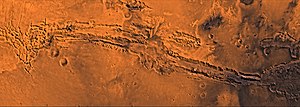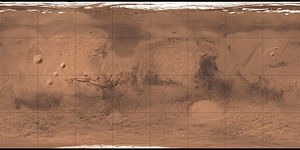Valles Marineris
| Rift Valley System on Mars | ||
|---|---|---|
| Valles Marineris | ||

|
||
| Panoramic view of the 4000 km long Mariner valleys | ||
|
|
||
| position | 10 ° S , 70 ° W | |
| expansion | 4000 km | |
| depth | 7000 m | |
| story | ||
| Named after | Mariner 9 probe | |
| Eponym | Latin for Mariner Valleys | |
The Valles Marineris ( Latin for Mariner Valleys ) are a vast rift system on Mars that extends along the equator to the east of the volcanic Tharsis region . With a length of 4000 km, a width of up to 700 km and a depth of up to 7000 m, the Valles Marineris are one of the largest rift systems in the solar system ; they are only surpassed by the rift systems on earth and (in length) by Baltis Vallis on Venus.
The Valles Marineris got their name in honor of the Mariner 9 probe , on whose photographic images they were discovered.
At the end of 2021, ESA announced that it had discovered large water deposits at the Valles Marineris one meter below the surface of Mars with the ExoMars Trace Gas Orbiter .
description

The rift system extends from its branch Noctis Labyrinthus on the Tharsis bulge in the west to the "chaotic areas" of Eos Chasma and Capri Chasma in the east. The Valles Marineris consist of several interconnected Chasmata or rift valleys , each of which exceeds the Grand Canyon (Arizona) many times over.
The Valles Marineris begin east of Noctis Labyrinthus ( 7 ° 0 ′ S , 96 ° 0 ′ W ), where they branch out into two parallel Chasmata: the northern Tithonium Chasma ( 4 ° 36 ′ S , 84 ° 17 ′ W ) and the southern Ius Chasma ( 7 ° 17 ′ S , 84 ° 23 ′ W ) , about 840 km east-west . To the east of Ius Chasma is the Melas Chasma ( 10 ° 31 ′ S , 72 ° 32 ′ W ) , which runs about 560 km in a south-easterly direction . This merges into Candor Chasma ( 6 ° 32 ′ S , 70 ° 47 ′ W ), located about 810 km to the north , which in turn joins the approximately 315 km wide, semicircular Ophir Chasma ( 4 ° 0 ′ S , 72 ° 21 ′ W ). To the southeast of Melas Chasma follows the Coprates Chasma ( 13 ° 22 ′ S , 60 ° 44 ′ W ) , which runs about 960 km in a south-easterly direction . It merges into the Eos Chasma ( 12 ° 9 ′ S , 39 ° 10 ′ W ), which runs about 1306 km in a northeasterly direction . To the north lies the Ganges Chasma ( 7 ° 58 ′ S , 47 ° 53 ′ W ), which runs about 574 km in an east-west direction, and to the northwest is the Capri Chasma, which runs about 1470 km in a north-easterly direction ( 8 ° 16 ′ S , 42 ° 4 ′ W ).
development
Over time there have been many different theories about formations such as the Valles Marineris. Before powerful telescopes or the Viking probes made more precise observations possible, it was assumed, among other things. Canals built by hypothetical Martians to irrigate their planet. This speculation was fueled by discoveries such as Schiaparelli's "Canali" (Mars channels) or other linear representations. In addition, the designation "Canali" (Italian for channels ) led to the wrong translation Kanal (or English Channel or Canal ).
In the 1970s one suspected inter alia. severe erosion from water released from the permafrost. However, liquid water is extremely unlikely on Mars, as the temperature on Mars rarely exceeds 0 ° C , even at the equator , and Mars has a very thin atmosphere (only 0.75% of the earth's atmospheric pressure ). In 1972 McCauley hypothesized that the rift system could have been created by sinking magma below the surface. In 1989 Tanaka and Golombek published a theory about the origin of tension caused by breaking. Nick Hoffman suspected in 2000 and after that Mars was not shaped by water, but by carbon dioxide in its early days, which is why he used the term "White Mars" for it. Hoffman postulated "cryoclastic currents", a mixture of gaseous and solid carbon dioxide, water ice and rock, which z. B. would have formed the Valles Marineris. Another theory postulates the formation of large dikes - on Earth, the plate-like, mostly far-reaching rock bodies are made of igneous rock, which fill larger crevices and cut or cross the surrounding rock. Magma rises through crevices in the Martian crust, melting the ice in the ground, creating large, rapidly draining masses of water.
The most widely accepted hypothesis currently (2005) is that the rift system was created by cracks in the crust and that it was greatly expanded by erosion and collapse. The reason for this is the development of the Tharsis region .
Rockslides deposited rocks at the bottom of the Valles Marineris, widening them. Possible triggers for rockslides are earthquakes caused by tectonic activities or impact events. It has been observed that the rock that has slipped off is shaped by the wind and forms, for example, dune fields.
See also
- Artemis Chasma (Venus)
Web links
- DLR: Louros Valles - ramified erosion valleys on the edge of the Mars canyon Valles Marineris April 8, 2004, archived on March 3, 2018
- DLR: Melas Chasma - Steep slope in the center of the Mars canyon Valles Marineris June 22, 2004, archived on March 2, 2018
- DLR: The "Gorge of Dawn" on Mars August 30, 2004, archived on March 3, 2018
- DLR: The five thousand meter deep Ophir Gorges on Mars September 27, 2004, archived on March 2, 2018
- DLR: Tithonium Chasma, western Valles Marineris November 3, 2004, archived on March 3, 2018
- DLR: Coprates Catena - a chain of deep depressions on the southern edge of the Valles Marineris Canyon November 17, 2004, archived on March 3, 2018
- DLR: The six kilometer high cliffs of Candor Chasma December 22, 2004, archived on March 3, 2018
- DLR : Melas Chasma, Candor Chasma and Ophir Chasma: The central part of the Valles Marineris February 15, 2005
- DLR: Coprates Chasma and the "chain of trenches" Coprates Catena in the eastern section of the Valles Marineris June 10, 2005
- DLR: Aram Chaos, east of the Valles Marineris May 30, 2006
- DLR: The deep valleys of Candor February 15, 2008
- DLR video: Overflight over the central part of the Valles Marineris December 20, 2011
- DLR: The eight kilometer high edge of Ius Chasma March 1, 2012
- DLR: Valles Marineris Explorer: Exploring Mars in a swarm May 15, 2012
- DLR: Valles Marineris - the largest canyon in the solar system October 22, 2012
- astronews.com: Young volcanoes in Coprates Chasma July 13, 2017
Individual evidence
- ↑ ExoMars discovers hidden water in Mars' Grand Canyon. Accessed December 19, 2021 .
- ↑ spacedaily.com, Dr Nick Hoffman: White Mars: The story of the Red Planet Without Water, October 19, 2000 , accessed January 27, 2014
- ^ Wilson, L., and JW Head III, Tharsis-radial graben systems as the surface manifestation of plume-related dike intrusion complexes: Models and implications, J. Geophys. Res., 107 (E8), doi : 10.1029 / 2001JE001593 , 2002.
- ^ Landslide and dune field in the northwest of Ius Chasma
